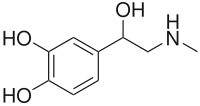
Photo from wikipedia
Objective(s): 4-Phenyl butyric acid (4-PBA) is a chaperone-mediated autophagy (CMA) inducer, which eliminates unnecessary and damaged cellular components through lysosomal enzymes. It could reduce misfolded and unfolded proteins produced after… Click to show full abstract
Objective(s): 4-Phenyl butyric acid (4-PBA) is a chaperone-mediated autophagy (CMA) inducer, which eliminates unnecessary and damaged cellular components through lysosomal enzymes. It could reduce misfolded and unfolded proteins produced after myocardial infarction (MI) and can improve cardiac function. We aimed to investigate the effect of 4-PBA on isoproterenol-induced MI in rats. Materials and Methods: Isoproterenol (100 mg/kg) was injected subcutaneously for two consecutive days simultaneous with an intraperitoneal (IP) injection of 4-PBA at 20, 40, or 80 mg/kg at 24-hr intervals for five days. On day 6, hemodynamic parameters, histopathological changes, peripheral neutrophil count, and total anti-oxidant capacity (TAC) were evaluated. The expression of autophagy proteins was measured by using western blotting. 4-PBA significantly improved post-MI changes in hemodynamic parameters. Results: Histological improvement was found in 4-PBA 40 mg/kg (P<0.05). The neutrophil count in the peripheral blood significantly decreased in the treatment groups compared with isoproterenol. Furthermore, 4-PBA at 80 mg/kg significantly increased the serum TAC compared with isoproterenol (P<0.001). Western blotting showed a significant decrease in the P62 level (P<0.05) of 40 and 80 mg/kg 4-PBA treated groups. Conclusion: This study demonstrated that 4-PBA could have a cardio-protective effect against isoproterenol-induced MI, which can be due to autophagy modulation and oxidative stress inhibition. Obtaining effective results in different doses shows the need for an optimum degree of cell autophagic activity.
Journal Title: Iranian Journal of Basic Medical Sciences
Year Published: 2023
Link to full text (if available)
Share on Social Media: Sign Up to like & get
recommendations!